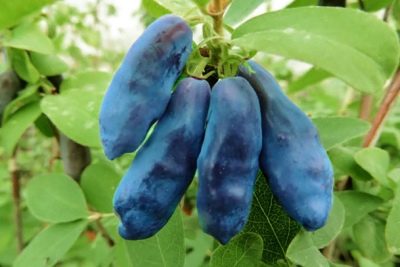
- Authors: Canadian selection
- Name synonyms: Blue Banana
- Growth type: vigorous
- Bush height, m: up to 1.5
- Escapes: sublime, non-leaning
- Crown: sprawling, obovate, dense
- Fruit size: very large
- Fruit weight, g: 3,5-4
- Fruit shape: elongated-oval, pointed at the ends
- Crumbling: do not crumble
Shrubs of edible honeysuckle are increasingly found in summer cottages. This is due to the fact that many unpretentious varieties have appeared that quickly adapt to the climate and bear fruit stably. Among the many species, the mid-late variety Blue Banana of Canadian selection deserves special attention.
Description of the variety
The blue banana is a vigorous, sprawling shrub with an obovate or domed crown that is heavily thickened with bright green leaves and strong and raised shoots. In the right environment, honeysuckle grows in height up to 1.3-1.5 m, expanding in diameter also up to 130-150 cm.
The flowering of the shrub is quite early: the end of April - the first week of May. During this period, the bush acquires a very beautiful decorative appearance, densely covered with medium snow-white or pale yellowish flowers, exuding a sweetish aroma.
Fruit characteristics
This type of honeysuckle belongs to the group of very large-fruited varieties. On an adult bush, berries are ripe with a mass of up to 4 grams and a length of up to 3 cm. The shape of the fruits is standard - elongated-oval, with pointed ends. Ripe honeysuckle has a beautiful purple color, diluted with a pronounced bluish bloom. The peel of the berry is moderately dense, not hard, with a noticeable tuberosity on the surface.
The berries stick to short and thickened stalks, pulling dry during harvest. Ripe fruits do not crumble. Harvested berries can be transported over short distances. The keeping quality of the fruit is average, like that of most edible honeysuckle varieties.
Honeysuckle Blue banana is characterized by a wide purpose - berries are eaten fresh, processed into jams, preserves, fruit drinks, frozen. In addition, honeysuckle (leaves, stems, fruits) is used in folk medicine.
Taste qualities
The blue banana is one of the most delicious varieties of honeysuckle. The flesh of the fruit is fleshy, dense, tender, juicy. The taste is unusual - incredibly sweet, even a little sugary, without bitterness and cloying. Excellent taste harmoniously combines with summer, sweetish aroma.
Ripening and fruiting
Canadian Honeysuckle The Blue Banana is a medium-late-ripening crop class. The shrub begins to bear fruit in the 3rd year after planting. The berries do not ripen at the same time, so the ripening process is long, it can last up to 4-5 weeks. There is no need to rush to remove the berries from the bushes, since they can hang in a ripe state and not crumble for 2-3 weeks. The phase of active ripening and fruiting begins in the second half of July.
Yield
High yield is the advantage of this variety. On average, up to 4 kg of useful berries (3.5-3.6 kg) can be removed from 1 bush per season. The maximum yield was recorded at 4.5 kg per shrub per season. From 1 hectare of plantations, you can get from 11 to 14.8 tons of edible honeysuckle.

Self-fertility and the need for pollinators
Honeysuckle The blue banana needs additional cross-pollination, so planting donor varieties on the site is indispensable. Planting 2-3 pollinating varieties at once is considered the most effective. Productive pollinators include: Heart of a Giant, Cubic Zirconia, Daughter of a Giant, Northern Lights, Honey Bee, Aurora.
Growing and care
You can plant a honeysuckle seedling in late autumn (October-November) and spring (early April). It is necessary to plan the planting in such a way that the distance between plantings is at least 1.5 meters. For planting, one-two-year-old seedlings are purchased, which take root best.
The agricultural technology of Canadian honeysuckle consists of basic measures: watering as needed, applying mineral fertilizers, liquid root feeding, disease prevention, crown formation, sanitary and rejuvenating branches removal, loosening, weeding and mulching of the soil, preparation for cold weather.


Disease and pest resistance
The immunity of the variety is sufficient to resist the shrub to many fungi and bacteria. Some diseases (powdery mildew, rust) can be caused by improper care or unfavorable weather. Spraying with insecticides and fungicides is used as a reliable prophylaxis.

Winter hardiness and the need for shelter
Blue banana has high frost resistance, surviving severe frosts down to -40 ... 45 degrees. Flower buds and shoots are also resistant to cold, so the shrub does not need shelter. Experts recommend sheltering only young seedlings.
Location and soil requirements
Honeysuckle is a culture that loves warmth, light, so it is comfortable for shrubs to grow in a sunny area, where there is protection from drafts. A site with fertile, breathable, moisture-permeable, loose soil with a neutral acidity index would be ideal. It is important that the groundwater table is deep, otherwise the roots may rot.
































































